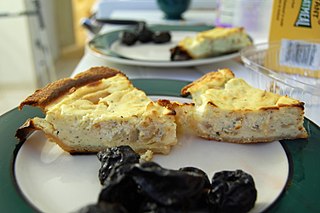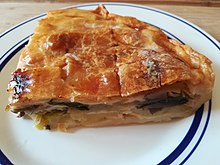
Argentine cuisine is described as a blending of cultures, from the Indigenous peoples of Argentina who focused on ingredients such as humita, potatoes, cassava, peppers, tomatoes, beans, and yerba mate, to Mediterranean influences brought by the Spanish during the colonial period. This led to cultural blending of criollos, Indigenous, and sub-Saharan African in the cuisine. Later, this was complemented by the significant influx of Italian and Spanish immigrants to Argentina during the 19th and 20th centuries, who incorporated plenty of their food customs and dishes such as pizzas, pasta and Spanish tortillas.

Raclette is a Swiss dish, also popular in the other Alpine countries, based on heating cheese and scraping off the melted part, then typically served with boiled potatoes. Raclette cheese is historically a dish originating from the canton of Valais in Switzerland. This cheese from Valais benefits from an AOP. Raclette cheese is also a Swiss-type cheese marketed specifically to be used for this dish.

A pasty is a British baked pastry, a traditional variety of which is particularly associated with Cornwall, South West England, but has spread all over the British Isles. It is made by placing an uncooked filling, typically meat and vegetables, in the middle of a flat shortcrust pastry circle, bringing the edges together in the middle, and crimping over the top to form a seal before baking.

in Austria and the Swabian, Bavarian and Franconian parts of Germany, 'leverkaas' in the Netherlands and Fleischkäse ("meat-cheese") in Saarland, Baden, Switzerland and Tyrol) is a specialty food found in the south of Germany, in Austria and parts of Switzerland, similar to bologna sausage. It consists of beef, pork and bacon and is made by grinding the ingredients very finely and then baking it as a loaf in a bread pan until it has a crunchy brown crust. Variations may be made using other kinds of meat such as horse meat or turkey, or may contain additional ingredients such as cheese or minced chili peppers.

Rösti or rööschti is a Swiss dish consisting mainly of potatoes, sautéed or shallow-fried in a pan. It was originally a breakfast dish, commonly eaten by farmers in the canton of Bern, but is now eaten all over Switzerland and around the world. The French name röstis bernois directly refers to the dish's origins.

Swiss cuisine is an ensemble of national, regional and local dishes, consisting of the ingredients, recipes and cooking techniques developed in Switzerland or assimilated from other cultures, particularly neighboring countries. The diversity and comprehensiveness of Swiss gastronomy reflects the linguistic, cultural and geographical diversity. The climate of Switzerland allows for a large variety of terroirs, and therefore a wide range of indigenous food, from simple cereals to refined products like cheese and wine.

Börek or burek is a family of pastries or pies found in the Balkans, Middle East and Central Asia. The pastry is made of a thin flaky dough such as filo with a variety of fillings, such as meat, cheese, spinach, or potatoes. Boreks are mainly associated with the Middle East, Armenia, and also with the former Ottoman Empire, including the Balkans and the South Caucasus, Eastern European and Central European countries, Northern Africa and Central Asia. A borek may be prepared in a large pan and cut into portions after baking, or as individual pastries. They are usually baked but some varieties can be fried. Borek is sometimes sprinkled with sesame or nigella seeds, and it can be served hot or cold.

Czech cuisine has both influenced and been influenced by the cuisines of surrounding countries and nations. Many of the cakes and pastries that are popular in Central Europe originated within the Czech lands. Contemporary Czech cuisine is more meat-based than in previous periods; the current abundance of farmable meat has enriched its presence in regional cuisine. Traditionally, meat has been reserved for once-weekly consumption, typically on weekends.

Colombian cuisine is a compound of the culinary traditions of the six main regions within Colombia. Colombian cuisine varies regionally and is particularly influenced by Indigenous Colombian, Spanish, and African cuisines, with slight Arab influence in some regions. As one of the most biodiverse countries in the world, Colombia has one of the widest variety of available ingredients depending on the region.

A meat pie is a pie with a filling of meat and often with other savory ingredients. They are found in cuisines worldwide.

Chilean cuisine stems mainly from the combination of traditional Spanish cuisine, Chilean Mapuche culture and local ingredients, with later important influences from other European cuisines, particularly from Germany, the United Kingdom and France. The food tradition and recipes in Chile are notable for the variety of flavours and ingredients, with the country's diverse geography and climate hosting a wide range of agricultural produce, fruits and vegetables. The long coastline and the peoples' relationship with the Pacific Ocean add an immense array of seafood to Chilean cuisine, with the country's waters home to unique species of fish, molluscs, crustaceans and algae, thanks to the oxygen-rich water carried in by the Humboldt Current. Chile is also one of the world's largest producers of wine and many Chilean recipes are enhanced and accompanied by local wines. The confection dulce de leche was invented in Chile and is one of the country's most notable contributions to world cuisine.

Liechtensteiner cuisine is the cuisine of Liechtenstein. The cuisine is diverse and has been influenced by the cuisine of nearby countries, particularly Switzerland and Austria, and is also influenced by Central European cuisine. Cheeses and soups are integral parts of Liechtensteiner cuisine. Milk products are also commonplace in the country's cuisine, due to an expansive dairy industry. Common vegetables include greens, potatoes and cabbage. Widely consumed meats include beef, chicken and pork. The consumption of three meals a day is commonplace, and meals are often formal.

Cheese and onion pie is a savoury dish, the basis of which is an outer layer of savoury pastry filled with a mixture of cheese, onion, herbs and sometimes potato. Many recipes contain Lancashire cheese, indicating parentage of North West England.

Wähe is a baked dish typical of Swiss and Alemannic (German) cuisine. A wähe consists of a casing and a topping of a custard enveloping either fruit, vegetables or cheese. The custard and fruits or vegetables are baked together. The preparation is thus very similar to that of the French quiche or tarte.

Älplermagronen is a dish from the Alpine regions of Switzerland, consisting of pasta, potatoes, cream, cheese, and onions. The name is made up of "Älpler" as a designation for the Alpine herder and "Magronen", which was taken as a loan word from the Italian word maccheroni.















